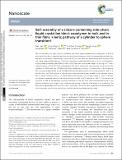| dc.contributor.author | Liao, Fen | |
| dc.contributor.author | Ran, Rong | |
| dc.contributor.author | Yager, Kevin G. | |
| dc.contributor.author | Shi, Lingying | |
| dc.contributor.author | Cheng, Li-Chen | |
| dc.contributor.author | Lee, Sangho | |
| dc.contributor.author | Ross, Caroline A | |
| dc.date.accessioned | 2019-02-04T15:57:24Z | |
| dc.date.available | 2019-02-04T15:57:24Z | |
| dc.date.issued | 2018-11 | |
| dc.date.submitted | 2018-09 | |
| dc.identifier.issn | 2040-3364 | |
| dc.identifier.issn | 2040-3372 | |
| dc.identifier.uri | http://hdl.handle.net/1721.1/120168 | |
| dc.description.abstract | The self-assembly of a high-χ silicon-containing side-chain liquid crystalline block copolymer (LC BCP) in bulk and in thin films is reported, and the structural transition process from the hexagonally packed cylinder (HEX) to the body-centered cubic structure (BCC) in thin films was examined by both reciprocal and real space experimental methods. The block copolymer, poly(dimethylsiloxane-b-11-(4′-cyanobiphenyl-4-yloxy)undecylmethacrylate) (PDMS-b-P(4CNB11C)MA) with a molecular weight of 19.5 kg mol−1 and a volume fraction of PDMS 27% self-assembled in bulk into a hierarchical nanostructure of sub-20 nm HEX cylinders of PDMS with the P(4CNB11C)MA block exhibiting a smectic LC phase with a 1.61 nm period. The structure remained HEX as the P(4CNB11C)MA block transformed to an isotropic phase at ∼120 °C. In the thin films, the PDMS cylindrical microdomains were oriented in layers parallel to the substrate surface. The LC block formed a smectic LC phase which transformed to an isotropic phase at ∼120 °C, and the microphase-separated nanostructure transformed from HEX to BCC spheres at ∼160 °C. The hierarchical structure as well as the dynamic structural transition of the thin films were characterized using in situ grazing-incidence small-angle X-ray scattering and grazing-incidence wide-angle X-ray scattering. The transient morphologies from the HEX to BCC structure in thin films were captured by scanning electron microscopy and atomic force microscopy, and the transition pathway was described. | en_US |
| dc.description.sponsorship | National Science Foundation (U.S.) (DMR-1606911) | en_US |
| dc.description.sponsorship | National Natural Science Foundation (China) (Grant 51403132) | en_US |
| dc.description.sponsorship | National Natural Science Foundation (China) (Grant 51773124) | en_US |
| dc.publisher | Royal Society of Chemistry | en_US |
| dc.relation.isversionof | http://dx.doi.org/10.1039/c8nr07685e | en_US |
| dc.rights | Creative Commons Attribution 3.0 unported license | en_US |
| dc.rights.uri | https://creativecommons.org/licenses/by/3.0/ | en_US |
| dc.source | Royal Society of Chemistry (RSC) | en_US |
| dc.title | Self-assembly of a silicon-containing side-chain liquid crystalline block copolymer in bulk and in thin films: kinetic pathway of a cylinder to sphere transition | en_US |
| dc.type | Article | en_US |
| dc.identifier.citation | Liao, Fen, Ling-Ying Shi, Li-Chen Cheng, Sangho Lee, Rong Ran, Kevin G. Yager, and Caroline A. Ross. “Self-Assembly of a Silicon-Containing Side-Chain Liquid Crystalline Block Copolymer in Bulk and in Thin Films: Kinetic Pathway of a Cylinder to Sphere Transition.” Nanoscale 11, no. 1 (2019): 285–293. © The Royal Society of Chemistry | en_US |
| dc.contributor.department | Massachusetts Institute of Technology. Department of Materials Science and Engineering | en_US |
| dc.contributor.mitauthor | Shi, Lingying | |
| dc.contributor.mitauthor | Cheng, Li-Chen | |
| dc.contributor.mitauthor | Lee, Sangho | |
| dc.contributor.mitauthor | Ross, Caroline A | |
| dc.relation.journal | Nanoscale | en_US |
| dc.eprint.version | Final published version | en_US |
| dc.type.uri | http://purl.org/eprint/type/JournalArticle | en_US |
| eprint.status | http://purl.org/eprint/status/PeerReviewed | en_US |
| dc.date.updated | 2019-01-17T13:46:32Z | |
| dspace.orderedauthors | Liao, Fen; Shi, Ling-Ying; Cheng, Li-Chen; Lee, Sangho; Ran, Rong; Yager, Kevin G.; Ross, Caroline A. | en_US |
| dspace.embargo.terms | N | en_US |
| dc.identifier.orcid | https://orcid.org/0000-0001-9975-9903 | |
| dc.identifier.orcid | https://orcid.org/0000-0003-4164-1827 | |
| dc.identifier.orcid | https://orcid.org/0000-0003-2262-1249 | |
| mit.license | PUBLISHER_CC | en_US |
